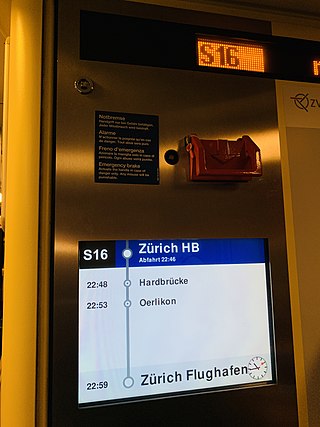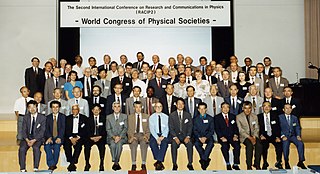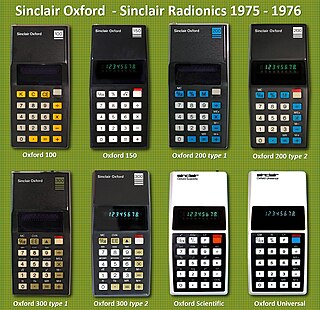
An electronic calculator is typically a portable electronic device used to perform calculations, ranging from basic arithmetic to complex mathematics.

A liquid-crystal display (LCD) is a flat-panel display or other electronically modulated optical device that uses the light-modulating properties of liquid crystals combined with polarizers to display information. Liquid crystals do not emit light directly but instead use a backlight or reflector to produce images in color or monochrome.

The Sinclair Scientific was a 12-function, pocket-sized scientific calculator introduced in 1974, dramatically undercutting in price other calculators available at the time. The Sinclair Scientific Programmable, released a year later, was advertised as the first budget programmable calculator.

A flat-panel display (FPD) is an electronic display used to display visual content such as text or images. It is present in consumer, medical, transportation, and industrial equipment.

The TI-30 is a scientific calculator manufactured by Texas Instruments, the first model of which was introduced in 1976. While the original TI-30 was discontinued in 1983 after several design revisions, TI maintains the TI-30 designation as a branding for its low and mid-range scientific calculators.
Sinclair Radionics Ltd was a company founded by Sir Clive Sinclair in Cambridge, England which developed hi-fi products, radios, calculators and scientific instruments.
Sinclair Research Ltd is a British consumer electronics company founded by Clive Sinclair in Cambridge in the 1970s. In 1980, the company entered the home computer market with the ZX80 at £99.95, at that time the cheapest personal computer for sale in the United Kingdom. A year later, the ZX81 became available through retailers, introducing home computing to a generation, with more that 1.5 million sold. In 1982 the ZX Spectrum was released, becoming the UK's best selling computer, and competing aggressively against Commodore and Amstrad.

The Sinclair Executive was the world's first "slimline" pocket calculator, and the first to be produced by Clive Sinclair's company Sinclair Radionics. Introduced in 1972, the calculator was produced in at least two versions with different keyboard markings; a variant called the Sinclair Executive Memory was introduced in 1973.
A thin-film-transistor liquid-crystal display is a type of liquid-crystal display that uses thin-film-transistor technology to improve image qualities such as addressability and contrast. A TFT LCD is an active matrix LCD, in contrast to passive matrix LCDs or simple, direct-driven LCDs with a few segments.
A settler is a person who has migrated, who takes up residence on land and cultivates it, as opposed to a nomad.
Albert H. Medwin was an American electrical engineer. He held several US patents, including ones in the field of electronic encoders. Medwin was involved in the early development of integrated circuits while working at RCA in Somerville, New Jersey. In the 1960s he led the engineering group that developed the world's first low power CMOS chips including a high speed shift register. He is also credited with leading the RCA group that introduced the 4000 series CMOS integrated circuit to the market.

Cyril Hilsum is a British physicist and academic.

The Sinclair Sovereign was a high-end calculator introduced by Clive Sinclair's company Sinclair Radionics in 1976. It was an attempt to escape from the unprofitable low end of the market, and one of the last calculators Sinclair produced. Made with a case of pressed steel that a variety of finishes, it cost between £30 and £60 at a time when other calculators could be purchased for under £5. A number of factors meant that the Sovereign was not a commercial success, including the cost, high import levies on components, competition from cheaper calculators manufactured abroad, and the development of more power-efficient designs using liquid-crystal displays. Though it came with a five-year guarantee, issues such as short battery life limited its usefulness. The company moved on to producing computers soon afterwards.

Sinclair Oxford was a range of low-cost scientific calculators manufactured and sold by Sinclair Radionics in England from 1975 until 1976.

The MK14 was a computer kit sold by Science of Cambridge of the United Kingdom, first introduced in 1977 for £39.95. The price was very low for a complete computer system at the time, and Science of Cambridge eventually sold over fifteen thousand kits.

The Sinclair Cambridge was a pocket-sized calculator introduced in August 1973 by Sinclair Radionics. It was available both in kit form to be assembled by the purchaser, or assembled prior to purchase. The range ultimately comprised seven models, the original "four-function" Cambridge – which carried out the four basic mathematical functions of addition, subtraction, multiplication, and division – being followed by the Cambridge Scientific, Cambridge Memory, two versions of Cambridge Memory %, Cambridge Scientific Programmable and Cambridge Universal.

The Amstrad PPC512 and Amstrad PPC640 were the first portable IBM PC compatible computers made by Amstrad. Released in 1987, they were a development of the desktop PC-1512 and PC-1640 models.

The FX-501P and FX-502P were programmable calculators, manufactured by Casio from 1978/1979. They were the predecessors of the FX-601P and FX-602P.

Solar-powered calculators are hand-held electronic calculators powered by solar cells mounted on the device. They were introduced at the end of the 1970s.

The fx-39 is a scientific calculator manufactured by Casio released in 1978 and is one of several models to share the same physical design format.















